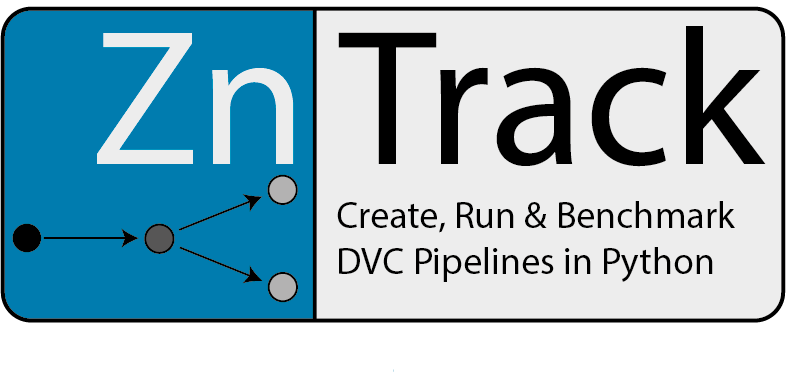
ZnTrack: A Parameter Tracking Package for Python
ZnTrack zɪŋk træk is a lightweight and easy-to-use package for tracking
parameters in your Python projects using DVC. With ZnTrack, you can define
parameters in Python classes and monitor how they change over time. This
information can then be used to compare the results of different runs, identify
computational bottlenecks, and avoid the re-running of code components where
parameters have not changed.
Key Features
- Parameter, output and metric tracking: ZnTrack makes it easy to store and track the values of parameters in your Python code. It further allows you to store any outputs produced and gives an easy interface to define metrics.
- Lightweight and database-free: Unlike other parameter tracking solutions, ZnTrack is lightweight and does not require any databases.
Getting Started
To get started with ZnTrack, you can install it via pip: pip install zntrack
Next, you can start using ZnTrack to track parameters, outputs and metrics in
your Python code. Here's an example of how to use ZnTrack to track the value of
a parameter in a Python class. Start in an empty directory and run git init
and dvc init for preparation.
Then put the following into a python file called hello_world.py and call it
with python hello_world.py.
import zntrack
from random import randrange
class HelloWorld(zntrack.Node):
"""Define a ZnTrack Node"""
# parameter to be tracked
max_number: int = zntrack.params()
# parameter to store as output
random_number: int = zntrack.outs()
def run(self):
"""Command to be run by DVC"""
self.random_number = randrange(self.max_number)
if __name__ == "__main__":
# Write the computational graph
with zntrack.Project() as project:
hello_world = HelloWorld(max_number=512)
project.run()This will create a DVC stage HelloWorld. The workflow is
defined in dvc.yaml and the parameters are stored in params.yaml.
This will run the workflow with dvc repro automatically. Once the graph is
executed, the results, i.e. the random number can be accessed directly by the
Node object.
hello_world.load()
print(hello_world.random_number)Tip
You can easily load a Node directly from a repository.
import zntrack node = zntrack.from_rev( "ParamsToMetrics", remote="https://github.com/PythonFZ/zntrack-examples", rev="8d0c992" )Try accessing the
paramsparameter andmetricsoutput. All Nodes from this and many other repositories can be loaded like this.
An overview of all the ZnTrack features as well as more detailed examples can be found in the ZnTrack Documentation.
Technical Details
ZnTrack as an Object-Relational Mapping for DVC
On a fundamental level the ZnTrack package provides an easy-to-use interface for
DVC directly from Python. It handles all the computational overhead of reading
config files, defining outputs in the dvc.yaml as well as in the script and
much more.
For more information on DVC visit their homepage.
References
If you use ZnTrack in your research and find it helpful please cite us.
@misc{zillsZnTrackDataCode2024,
title = {{{ZnTrack}} -- {{Data}} as {{Code}}},
author = {Zills, Fabian and Sch{\"a}fer, Moritz and Tovey, Samuel and K{\"a}stner, Johannes and Holm, Christian},
year = {2024},
eprint={2401.10603},
archivePrefix={arXiv},
}Copyright
This project is distributed under the Apache License Version 2.0.
Similar Tools
The following (incomplete) list of other projects that either work together with ZnTrack or can achieve similar results with slightly different goals or programming languages.
- DVC - Main dependency of ZnTrack for Data Version Control.
- dvthis - Introduce DVC to R.
- DAGsHub Client - Logging parameters from within .Python
- MLFlow - A Machine Learning Lifecycle Platform.
- Metaflow - A framework for real-life data science.
- Hydra - A framework for elegantly configuring complex applications
- Snakemake - Workflow management system to create reproducible and scalable data analyses.



